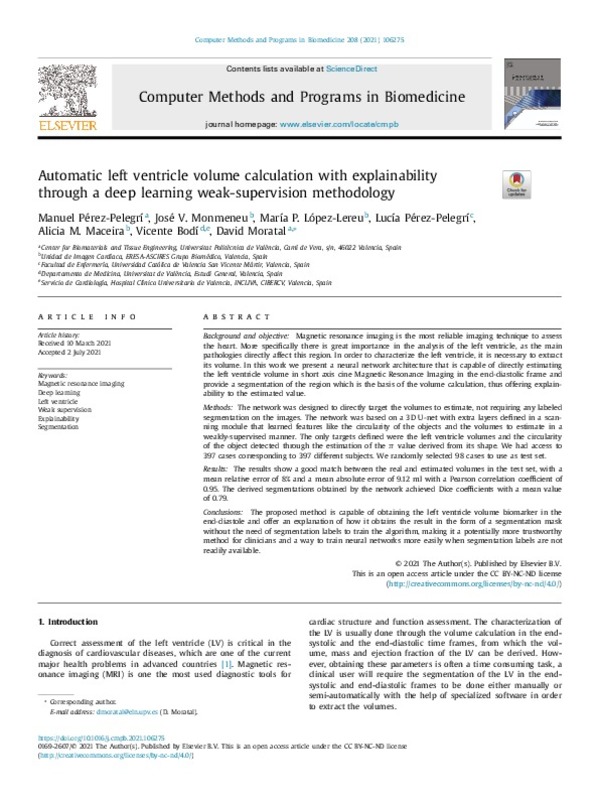Pérez-Pelegrí, M.; Monmeneu, JV.; López-Lereu, MP.; Pérez-Pelegrí, L.; Maceira, AM.; Bodi, V.; Moratal, D. (2021). Automatic left ventricle volume calculation with explainability through a deep learning weak-supervision methodology. Computer Methods and Programs in Biomedicine. 208:1-8. https://doi.org/10.1016/j.cmpb.2021.106275
Por favor, use este identificador para citar o enlazar este ítem: http://hdl.handle.net/10251/181741
|
Título:
|
Automatic left ventricle volume calculation with explainability through a deep learning weak-supervision methodology
|
|
Autor:
|
Pérez-Pelegrí, Manuel
Monmeneu, Jose V.
López-Lereu, María P.
Pérez-Pelegrí, Lucía
Maceira, Alicia M.
Bodi, Vicente

 Moratal, David
Moratal, David
|
|
Entidad UPV:
|
Universitat Politècnica de València. Departamento de Ingeniería Electrónica - Departament d'Enginyeria Electrònica
|
|
Fecha difusión:
|
|
|
Resumen:
|
[EN] Background and objective: Magnetic resonance imaging is the most reliable imaging technique to assess the heart. More specifically there is great importance in the analysis of the left ventricle, as the main pathologies ...[+]
[EN] Background and objective: Magnetic resonance imaging is the most reliable imaging technique to assess the heart. More specifically there is great importance in the analysis of the left ventricle, as the main pathologies directly affect this region. In order to characterize the left ventricle, it is necessary to extract its volume. In this work we present a neural network architecture that is capable of directly estimating the left ventricle volume in short axis cine Magnetic Resonance Imaging in the end-diastolic frame and provide a segmentation of the region which is the basis of the volume calculation, thus offering explain-ability to the estimated value.
Methods: The network was designed to directly target the volumes to estimate, not requiring any labeled segmentation on the images. The network was based on a 3D U-net with extra layers defined in a scan-ning module that learned features like the circularity of the objects and the volumes to estimate in a weakly-supervised manner. The only targets defined were the left ventricle volumes and the circularity of the object detected through the estimation of the pi value derived from its shape. We had access to 397 cases corresponding to 397 different subjects. We randomly selected 98 cases to use as test set.
Results: The results show a good match between the real and estimated volumes in the test set, with a mean relative error of 8% and a mean absolute error of 9.12 ml with a Pearson correlation coefficient of 0.95. The derived segmentations obtained by the network achieved Dice coefficients with a mean value of 0.79.
Conclusions: The proposed method is capable of obtaining the left ventricle volume biomarker in the end-diastole and offer an explanation of how it obtains the result in the form of a segmentation mask without the need of segmentation labels to train the algorithm, making it a potentially more trustworthy method for clinicians and a way to train neural networks more easily when segmentation labels are not readily available.
[-]
|
|
Palabras clave:
|
Magnetic resonance imaging
,
Deep learning
,
Left ventricle
,
Weak supervision
,
Explainability
,
Segmentation
|
|
Derechos de uso:
|
Reconocimiento - No comercial - Sin obra derivada (by-nc-nd)
|
|
Fuente:
|
Computer Methods and Programs in Biomedicine. (issn:
0169-2607
)
|
|
DOI:
|
10.1016/j.cmpb.2021.106275
|
|
Editorial:
|
Elsevier
|
|
Versión del editor:
|
https://doi.org/10.1016/j.cmpb.2021.106275
|
|
Código del Proyecto:
|
info:eu-repo/grantAgreement/MCIU//CIIP-20192020/
info:eu-repo/grantAgreement/CDTI//E9113//EUROSTARS project/
info:eu-repo/grantAgreement/AVI//INNCAD00%2F19%2F085//Proyecto 4DTools: nuevas técnicas y biomarcadores para diagnóstico-pronóstico de patologías de la aorta ascendente a través de técnicas de imagen médica/
info:eu-repo/grantAgreement/GVA//AEST%2F2019%2F037/
info:eu-repo/grantAgreement/GVA//AEST%2F2020%2F029//Aplicación de técnicas de deep learning (aprendizaje profundo) para un análisis automático de imágenes de Resonancia/
|
|
Agradecimientos:
|
The authors acknowledge financial support from the Consel-leria d'Educacio, Investigacio, Cultura i Esport, Generalitat Valenciana (grants AEST/2019/037 and AEST/2020/029) , from the Agencia Valenciana de la Innovacion, ...[+]
The authors acknowledge financial support from the Consel-leria d'Educacio, Investigacio, Cultura i Esport, Generalitat Valenciana (grants AEST/2019/037 and AEST/2020/029) , from the Agencia Valenciana de la Innovacion, Generalitat Valenciana (ref. INNCAD00/19/085) , and from the Centro para el Desarrollo Tecnologico Industrial (Programa Eurostars2, actuacion Interempresas Internacional) , Spanish Ministerio de Ciencia, Innovacion y Universidades (ref. CIIP-20192020) .
[-]
|
|
Tipo:
|
Artículo
|









